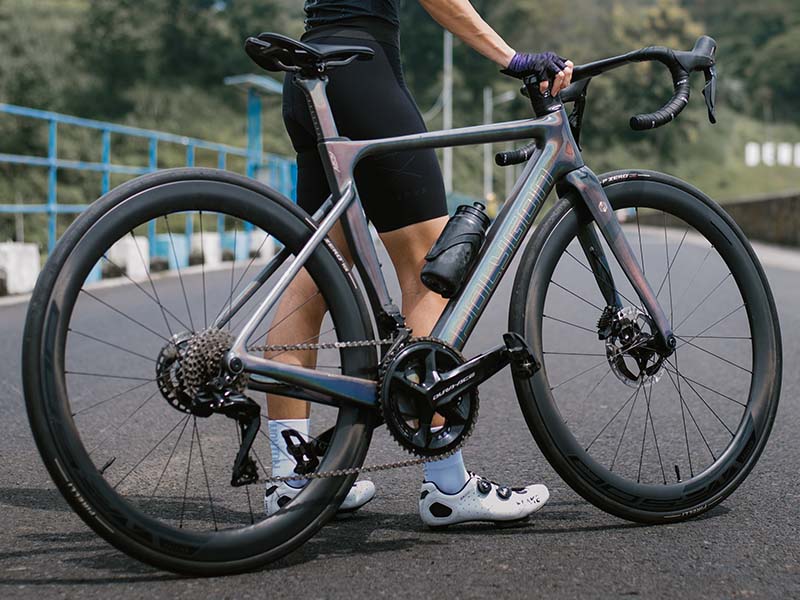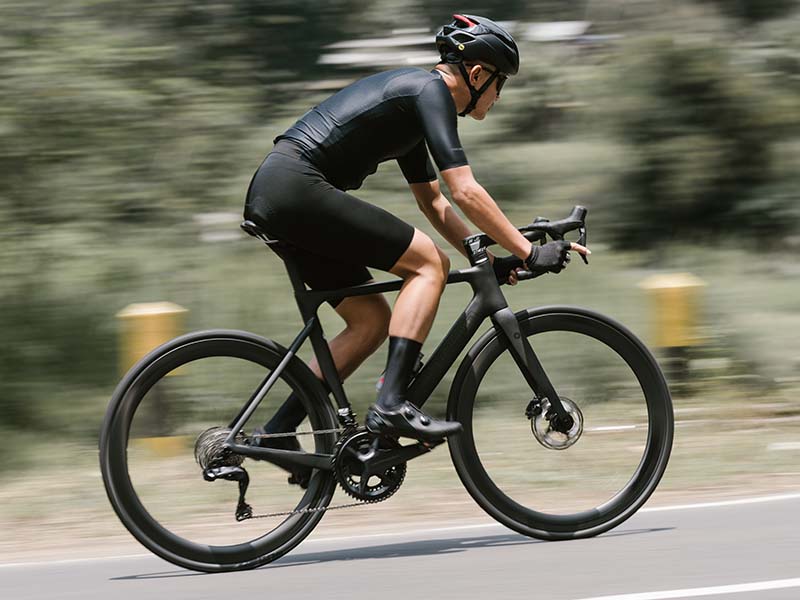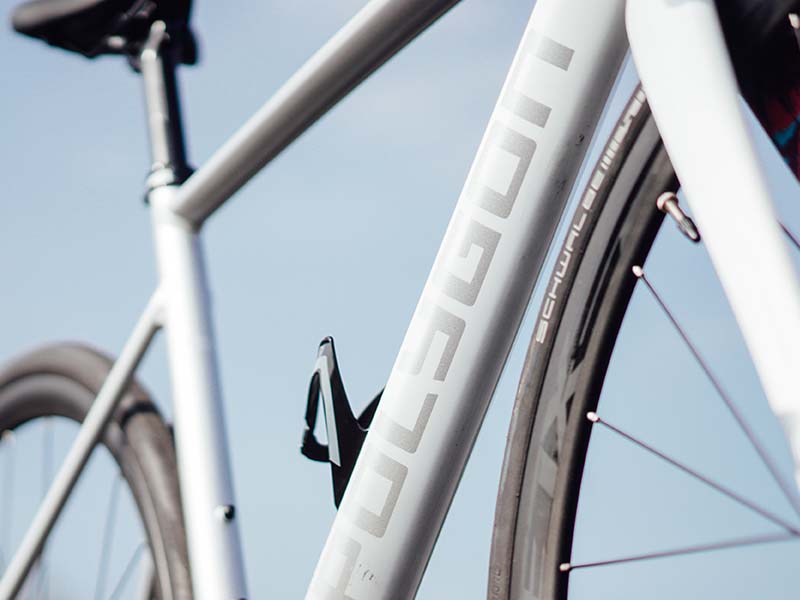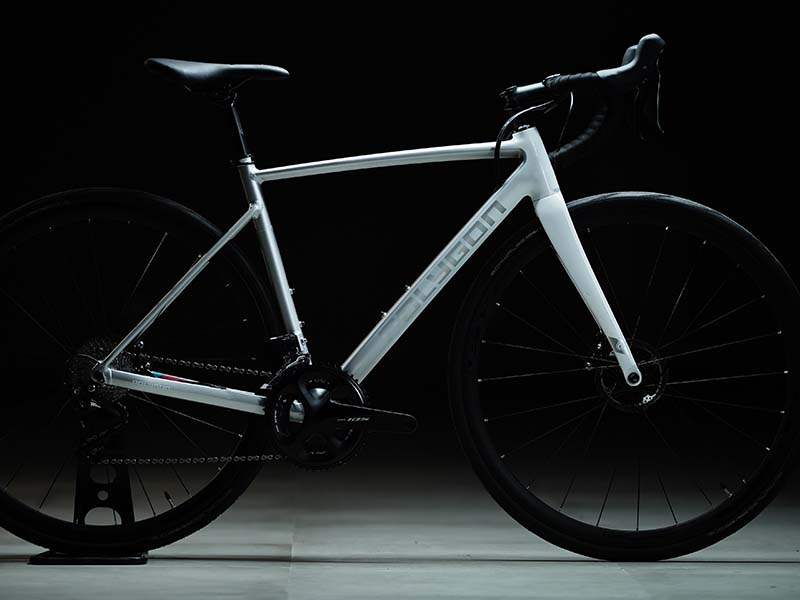When it comes to choosing a road bike, one of the key decisions you’ll face is selecting the right frame material. The options often boil down to carbon fibre and aluminium (alloy), each with its advantages and considerations.
By understanding the characteristics of these materials, you’ll be better equipped to make an informed decision that suits your riding style, budget, and preferences. So, let’s explore the differences between carbon and aluminium frames to help you find the perfect road bike for your cycling adventures.
Carbon Frames in Road Bike

Carbon frames in road bikes are often associated with a higher price tag compared to other frame materials. This type of frame is meticulously crafted through a composite manufacturing process. This involves layering and bonding carbon fibre sheets, composed of thousands of thin carbon filaments, using a specialised resin. The precise layering and orientation of these carbon fibres are crucial in determining the frame’s strength, lightness, and stiffness.
Once the layers are aligned and bonded, the composite is placed in a mould and subjected to high pressure and heat. This process, known as curing, solidifies the resin and creates a rigid structure. The frame is carefully finished, including the addition of components such as dropouts, bottom bracket shells, and cable guides.
Benefits of Carbon Frames in Road Bikes

Carbon frames offer several advantages when it comes to road bikes. Firstly, they provide an exceptional strength-to-weight ratio, meaning they are incredibly strong while remaining lightweight. This strength allows carbon frames to efficiently transfer power from the rider to the road, resulting in excellent acceleration and responsiveness. It also enhances the overall stability and control of the bike, particularly during high-speed descents or sharp turns.
Secondly, the lightness of carbon frames is a significant benefit for road bikes. The inherent lightweight nature of carbon fibre allows for effortless climbing and improved manoeuvrability. It reduces the overall weight of the bike, making it easier to handle and accelerate. This weight reduction not only enhances the speed and efficiency of the bike but also reduces the strain on the rider during long rides, enabling them to maintain higher speeds for longer periods.
Thirdly, carbon frames are renowned for their stiffness, which plays a crucial role in road bike performance. The stiffness of a frame refers to its resistance to flexing or bending under load. Carbon frames excel in this aspect, offering optimal power transfer with minimal energy loss. The stiffness of carbon frames ensures that the majority of the rider’s effort is effectively translated into forward motion, resulting in a more efficient and dynamic riding experience. It also enhances the bike’s ability to handle and respond to sudden changes in direction, providing a precise and controlled ride.
Find Carbon Frame Bikes
Considerations of Carbon Frames in Road Bikes
Firstly, budget is a significant factor. Carbon frames tend to be more expensive than aluminium frames due to the intricate manufacturing process and high-quality materials involved. It’s crucial to determine your spending and weigh the benefits of a carbon frame against its cost.
Repairability is an important aspect to consider as well. In the event of damage, carbon frames require specific repair techniques and expertise. Unlike aluminium frames that can be easily repaired or welded, carbon frames usually require professional repair services. It’s worth considering the availability and cost of repair options in your area.
Lastly, take into account your riding style and the type of terrain you frequently encounter. While carbon frames excel in road bike applications, they may not offer the best choice for extremely rough off-road trails or aggressive mountain biking. Assess whether a carbon frame aligns with your specific riding needs and preferences.
Read More: Road Bike vs Mountain Bike
SHOP AFFORDABLE CARBON ROAD BIKE
Alloy Frames in Road Bike

Aluminium frames, which are often called Alloy frames, have long been a popular choice for road bikes due to their durability, affordability, and versatility. These frames are typically made from various aluminium alloys, which undergo different manufacturing processes to achieve the desired strength and performance characteristics.
Alloy frames are constructed using a technique called welding, where individual aluminium tubes are joined together using heat and specialized welding techniques. This process allows for the creation of intricate frame designs, including aerodynamic shapes and optimized tube profiles.
Benefits of Alloy Frames in Road Bikes

Aluminium is an inherently strong material, providing robustness and resistance to impacts and vibrations. This strength ensures the frame can withstand the rigours of road cycling, including rough surfaces, potholes, and occasional accidents. Alloy frames offer excellent durability, making them suitable for long-term use and regular training rides.
Another notable benefit of alloy frames is their affordability. Compared to carbon frames, alloy frames are generally more budget-friendly, making them accessible to a wider range of cyclists. This cost-effectiveness allows riders to invest in other components or accessories, enhancing their overall biking experience.
Alloy frames also exhibit good stiffness characteristics, contributing to efficient power transfer and responsive handling. The rigidity of these frames allows for an immediate pedalling response, translating into quick acceleration and precise control. This stiffness enhances the bike’s overall stability and responsiveness, particularly during sprints or climbing steep inclines.
Considerations of Alloy Frames in Road Bikes
There are a few considerations to keep in mind when opting for an alloy frame. Firstly, alloy frames tend to be slightly heavier than carbon frames. While advancements in aluminium technology have reduced weight, carbon frames still offer a weight advantage, especially for riders seeking the utmost performance in terms of climbing and acceleration.
Additionally, alloy frames may transmit more road vibrations compared to carbon frames, which can impact overall ride comfort, especially on longer rides. However, the use of carbon forks, seat posts, and handlebars can help mitigate this to some extent.
Lastly, it’s important to note that alloy frames may not have the same level of customization and aerodynamic efficiency as carbon frames. Carbon frames allow for more intricate designs and can be engineered to optimize aerodynamics, whereas alloy frames may have limitations in terms of aerodynamic performance.
Conclusion

When choosing a road bike frame, the decision between carbon and alloy frames is crucial. Carbon frames offer exceptional strength, lightness, and stiffness, allowing for efficient power transfer, effortless climbing, and precise handling. However, they come at a higher cost and require specialized repairs. Alloy frames, on the other hand, provide durability, affordability, and good stiffness characteristics, although they may be slightly heavier and transmit more road vibrations. Consider your budget, repairability, riding style, and terrain to make an informed choice that suits your needs and preferences.
Once you have made the decision, go check the ongoing promotion at Rodalink Shop to get the best price while having 0% installments, free delivery to your home, and even a shop now pay later purchase method.






